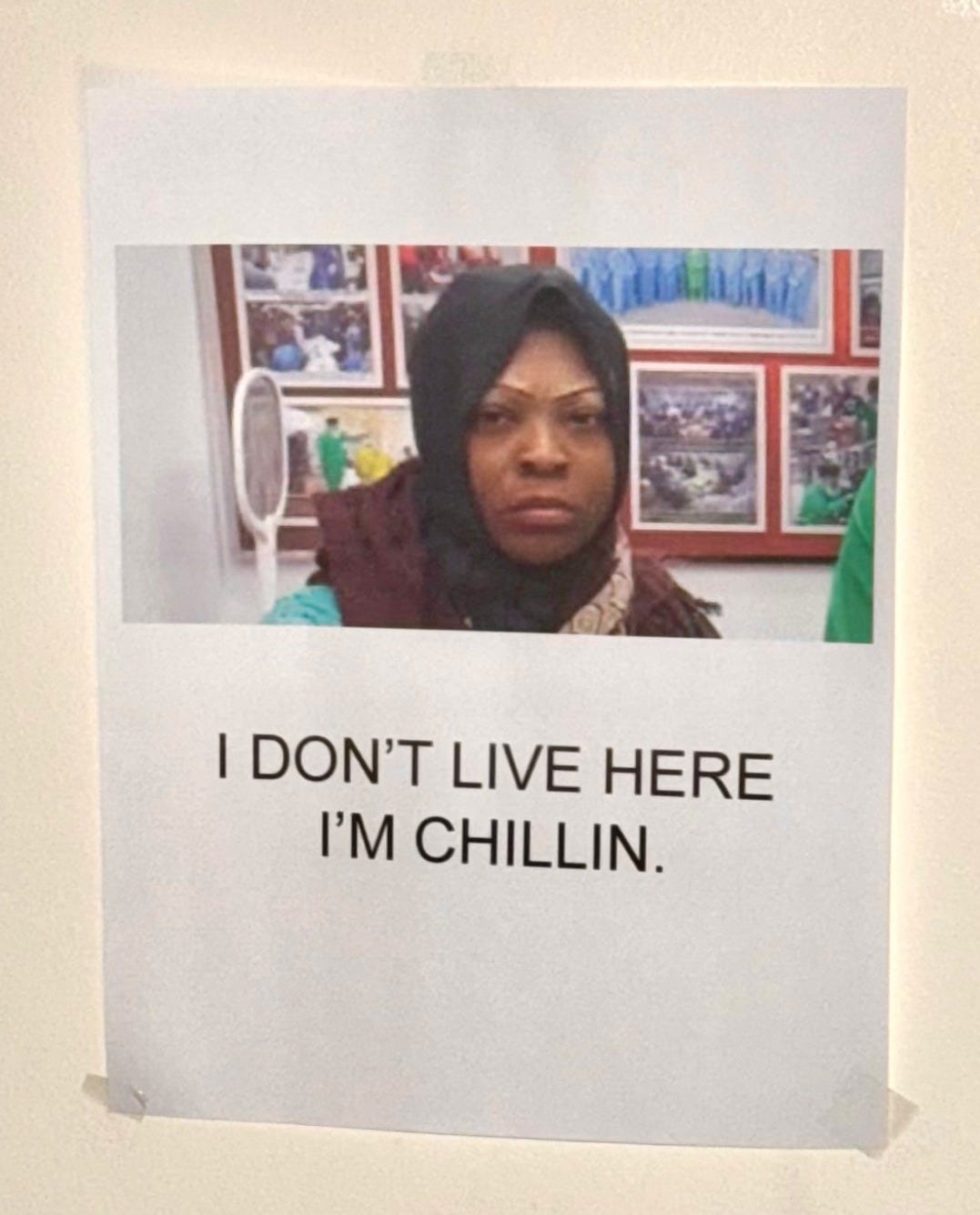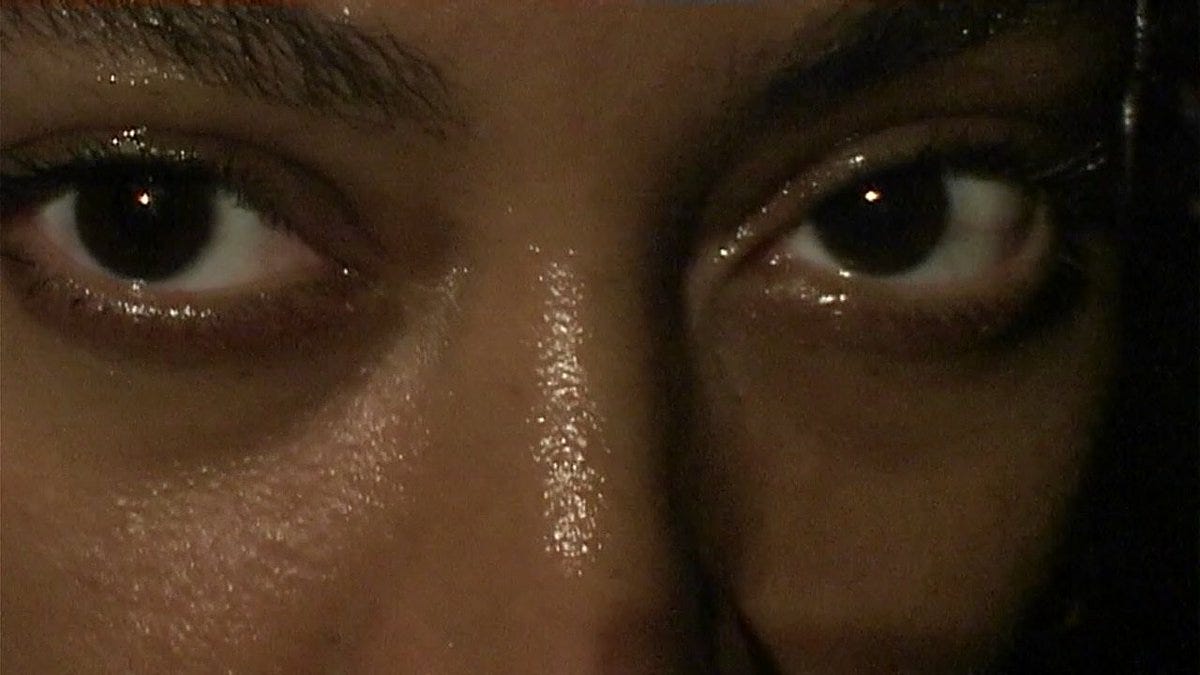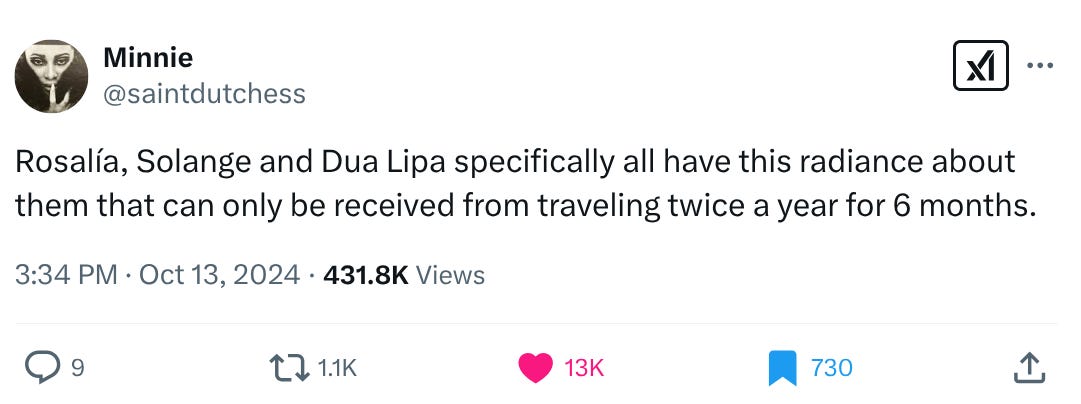Hot Girls Don’t Geotag
where in the world is onijah andrew robinson and solange?
“Satellite can’t find her.” — Bunny Is A Rider, Caroline Polachek (2021).

In Pakistan, Onijah has become someone else. Hooded in a silk hijab that frames unevenly stenciled eyebrows, she hides under quick drag. She’s that friend that changes her personality when she goes on vacation. Adopts a new accent, saying ‘You know what? I could live here’ after one cocktail. Her environment becomes her inspiration but she remains the muse.
There’s something very Carrie-Mathison-in-Homeland-coded about Onijah. Even her origin story of moving to Pakistan to pursue a relationship with a 19-year-old mimics one from the television series. In the fourth season, Carrie, a 35-year-old CIA agent, develops a relationship with Aayan, a naive Pakistani teenager, as part of her mission1. At the height of their relationship, Carrie, controversially, sleeps with the teenager in order to persuade him to reveal information about his terrorist uncle — a ruse that results in Aayan’s death. Thankfully, Onijah’s relationship doesn’t get that far. Upon landing in Pakistan, 7,560 miles from her homeland of America, she was swiftly rejected by her Pakistani fiancée at the airport, who claimed she looked different than how she presented online. But instead of packing it up and heading home, Onijah stays. Rejection is redirection, a tale fit for Tulathimutte.
First, Onijah refuses to leave until the government reimburses her travel expenses. Okay, fair. But then, with the attention of the Pakistani press at her fingertips as she camps outside of her would-be-husband’s home, she shares plans to stay with an unearned authority. Now, she wishes to work with the government to re-develop Pakistan:
“My plan is to reconstruct this whole country. I am asking for $100,000 or more. I need $20,000 by this week, in my pockets, in cash. That’s a demand to the government. The government is going to fix up these buildings, fix up these streets, and clean up these streets. It’s ridiculous out here. I don’t like it.”
Reconstruct Pakistan. A platform worthy of an American intelligence agent. Worthy of Homeland’s Mathison.
But just who is Onijah, really?
The stories that have emerged about Onijah are inconclusive and disparate, patchworked from street videographers and news outlets that manifest in fragmented clips. Her lore, strung together by memes and fancams, are straight from the Luigi Mangione playbook.
And yet, through this new identity Onijah has found attention, staff — Shabanna! — and agency while remaining under the veil of mystery. Confusion laces her journey, her past and present whereabouts. Perhaps confusion is the only destination she is concerned with.
She’s a con but isn’t all travel? Trying on a new identity, suspending the membership of your normal life to hover to and cosplay a new one? There is an element of tourism that requires cultural interloping and catfishing. Onijah knows all about this. After all, this is the woman who secured a Nikkah, an Islamic marriage certificate, under the most comedic of false pretenses: using a blonde white woman internet filter. Maybe she really is Carrie Mathison. She don’t cook, she don’t clean but an Instagram filter is how she (almost) got that ring.
Her exchange with a reporter has now become a trending sound on TikTok:
Reporter: “Where are you from?”
Onijah: “I’m from Pakistan.”
Reporter: “You’re not from Pakistan.”
Onijah: “Yes, I am.”
Reporter: “You’re born in Pakistan?”
Onijah: “No, but I’m from here.”
Reporter: “You’re born here?”
Onijah: “I’m from here.”
Reporter: “Right. You’re from here.”
It’s difficult to understand just where her gumption comes from or why she is adamant on assuming Pakistan as her home. But Onijah is not concerned with origins so neither should we. Since coming across our screens in January, stories have emerged about her whereabouts. Some say she’s been arrested and detained in a mental institution. Others say she’s happy and safe back in New Jersey. Recently, I saw a video of her vaping in Dubai, gallivanting down the street while a myriad of press followed her. I have no idea where she is now. But I do know that the next time we see her, she’ll be something else entirely. The star of a Marc Jacobs or Telfar bag campaign, most likely.
Travelling is funny that way. The way it can unbound you from an identity. In Shakersss.mov, a new video project from Solange, the artist captures this shedding of self as she traverses across Yucatán, Miami and New York. The short film is weaved with loose, interconnected clips from a handheld VHS; the only constant is the focus on Solange’s body, grasping at her through mirror shots and make-shift stands, as she vibrates to music. Fiona Apple, Joni Mitchell and Elbernita Clark are some of the many women who populate the soundscape, along with rapper Cam’ron.
In a taxi, Solange shoots a front-facing video, singing along to the driver’s merengue only for the next clip to be her dancing to the Spanish-language song in the privacy of her hotel room. By osmosis, she takes bits and pieces of her surroundings for the film, for herself. She’s Columbus with a camcorder.
Solange’s home of Texas has been the focal point of much of her work; her hometown mall in Houston was the setting for the 2013 ‘Lovers in The Parking Lot,’ and her most recent album, When I Get Home, was cut with samples of women from Houston’s Third Ward, with the accompanying film partially inspired by the devastation of Hurricane Harvey. The film is now a part of the Criterion Collection. But with Shakersss.mov, now being screened at the Museum of Contemporary Art in Los Angeles, Solange loses the muse of Houston. With her hands now free to clutch the camera, she grips the visual language of alternate destinations — the blue ribboned altar bells of Mexico, the blue waters of a beach in Miami — to saturate a new focus: herself.
With Onijah, you get the sense that her voyage has allowed her to occupy a new identity whereas Solange’s travel is about freeing herself from one. Liberation fuels her journey, a shaking free of self, as the title suggests, as if she is unburdening herself from previous entrapments. On the run but in pursuit of something within. I think back to her Grammy-award winning song ‘Cranes In The Sky,’ in which the singer references travel as one of many distractions from sadness:
I tried to run it away
Thought then my head'd be feeling clearer
I traveled seventy states
Thought moving 'round'd make me feel better
In the short film, travel is no longer used as a tool for obfuscation but for introspection instead.
The portrayal of water throughout the film is significant, as she dunks, bathes, and rinses herself in the bodies she comes across. In a short text coupled with the film, Solange writes “If you water the questions enough, answers will rise within you with unshakable faith. To hold a mirror to myself when I needed to see her the most.” The water becomes her mirror, baptism by travel.
There’s an extended scene, presumably in New York, where we see Solange record others. It’s at what looks to be a house party, in a penthouse adorned with candles and fancy table settings. It's the part of the night where everyone takes a turn playing DJ and the vignettes we see are wobbly and intimate. In them, Solange dances around, capturing her guests over clipped conversation and hip hop. The rapper JT twerks along with Solange in a few scenes, also shaking herself free with the help of the music. Suddenly, Solange plays a song by the rapper and aims the lens at the city girl, who is now singing along to the catchy hook: “I used to be down bad but now a bitch okay.” The bad bitch wiggles herself free at last.
I love these tweets so much because, honestly, like, good for her. There are certain people that you see on Instagram that are always travelling. You have no idea what they do or how they can afford their lifestyle but you’re here for it. They seem happy and free, liberated from their environments and never too attached to a particular version of themselves. I imagine that people like this never get jetlagged as they blend into their surroundings, dilly-dallying in the local dialect. I always like their posts and then send to my groupchat “Where the HELL are they now???” But baddies never geotag.

Travellers like Onijah, Solange and the ones above remind me of a modern incarnation of Carmen Sandiego, a fictional video game character who is sort of this good-agent-gone-bad chica. From what I remember, Ms. Sandiego is calculated and shifty with a stylish big hat. She is always on the run and impossible to locate, hence the title of the 1985 game Where in the World is Carmen Sandiego? I guess they didn’t have Find My Friends back then. The video game has since been expanded into a board game, a Netflix show, a game show, a concert series and film. When I look up the locations she hopped around to in the original game, I’m taken by the expansiveness. Kathmandu, Cairo, Singapore, Colombo, Montreal, Reykjavik. You never catch up to her but that’s sort of the point. There are some women you can follow but never find.
LOOSEY is a bi-weekly newsletter about culture, technology, and the way we live. If this is something you like, consider subscribing and sharing. Let’s be friends on Instagram.
Aayan eventually is killed by his uncle after he confesses to Carrie that he is still alive. Carrie cries some really good White Tears™ and continues on being an absolute menace for four more seasons. She’s one of my favourite television characters of all time <3 I wonder what her star sign is.









Can we talk about solange every week?
i want to live inside ur brain